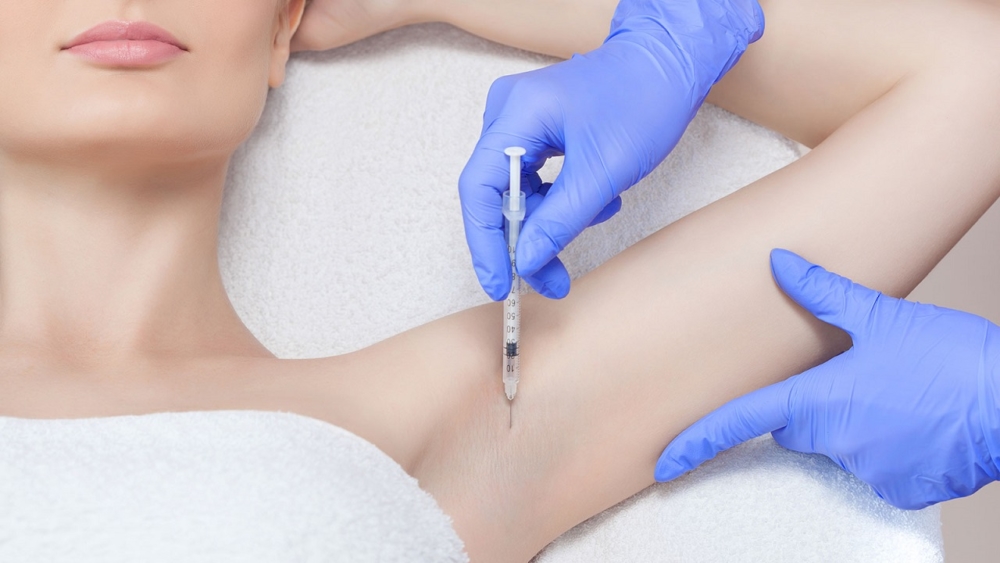Increased sweating causes a lot of inconvenience in everyday life, however, many people are used to hushing up this problem, considering it something shameful. Needless to say, many people, in addition to the banal use of deodorant, do not make any more attempts to get rid of hyperhidrosis. In this case, Botox in the armpits will be a real salvation for all those who are tired of unsuccessfully fighting excessive sweating.
Material Content:
Why do you need Botox in the armpits?
The main active ingredient of the drug is botulinum toxin, which is produced by bacteria of the genus Clostridium botulinum. This protein neurotoxin is a poison dangerous to the human body, however, in small concentrations it does not carry any danger.
For several decades, botulinum toxin has been actively used in cosmetology to solve a wide variety of aesthetic problems. The drug eliminates muscle cramps, thereby removing deep facial wrinkles. Botox was used as a remedy for sweat back in 1994. This method was the most effective and demonstrated a long lasting stable result.
The principle of action of antipsychotics is simple: it blocks nerve impulses from the brain to the sweat glands. As a result, the natural process of thermoregulation is not disturbed, however, the intensity of perspiration is significantly reduced.
How many injections are needed
Studies show that the administered drug begins to act 3 days after the procedure.The maximum effect is observed after 2 weeks. The number of injections is selected by a specialist, taking into account the individual characteristics of your body.
The exact answer to the question of how many Botox units are needed for the armpits will be given only by the doctor. For this, he takes into account the area of the sweating zone, on the basis of which the amount of botulinum toxin used is selected. As a rule, not more than 80-100 units of the drug are required for both axillary cavity zones.
Pros and cons of the procedure
Botox treatment is the most effective way to eliminate excessive sweating. The main advantages of the procedure include the following:
- Duration The procedure itself takes no more than 20-40 minutes. At the same time, the result obtained is stored for 6-9 months (provided that a high-quality preparation has been used).
- Efficiency. Botox or "Dysport" blocks the connection of the brain with the glands, as a result of which secretion is significantly reduced.
- Lack of surgery. After botulinum toxin injections, no visible marks or scars remain on the skin. The process itself is carried out on an outpatient basis and does not require the use of anesthesia.
- Security. The minimum concentration of the active substance does not pose any threat to the patient's life. Botox treatment of hyperhidrosis has been practiced since 1994. During this time, no side effects were detected.
- Minimum restrictions. After the procedure, you do not need to radically change your lifestyle and limit yourself to something. An exception can only be trips to the sauna, as well as grueling sports.
Note! Botulinum toxin is used only in case of primary hyperhidrosis. A more severe secondary form of the disease requires careful medical research to establish the true cause of such a violation.
If we talk about the shortcomings, then this method has a high cost. The average price of treatment varies from 25 to 35 thousand rubles.
Why botox treatment of hyperhidrosis did not help
As noted above, the procedure demonstrates a pronounced steady effect already 3 days after the procedure. An unsatisfactory result may be the result of improperly performed equipment if the doctor has introduced an insufficient amount of the drug. And also the effect obtained depends on the quality of the Botox used. It is unlikely that the treatment will be successful if a cheap analogue of botulinum toxin was introduced.
The consequences and contraindications of Botox injections
Botox treatment for hyperhidrosis is safe for a healthy body. And yet, experts do not recommend women to have a session several days before and after menstruation, when immunity is especially vulnerable. Any wounds, skin ulcers or exacerbated chronic diseases are also a reason to postpone the procedure.
Botox treatment is contraindicated in the following cases:
- during pregnancy and breastfeeding;
- in the presence of diabetes;
- in case of detection of malignant tumors or oncology;
- if there is an individual intolerance to protein components;
- with disorders of the central nervous system.
Immediately after administration of the drug, an unpleasant tingling sensation arises, as well as a slight swelling of the treated skin areas. The very next day, these sensations completely pass. If the dose of the active substance was exceeded, the drug was administered too deeply or if the sterility conditions were not met by the doctor, then the pain syndrome may disturb the patient for a longer time.
In addition to pain, side effects in the form of dizziness, nausea and general weakness of the whole organism can be observed. To avoid negative consequences, use the services of trusted professionals who have the appropriate license and all the necessary certificates.















